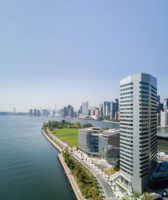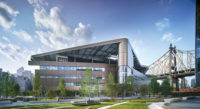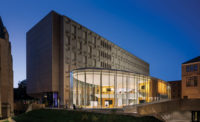In designing The Bridge for the new Cornell Tech campus in New York, Weiss/Manfredi faced several architectural challenges. As part of the first phase of creating this engineering and computer-science complex for Cornell University and Technion-Israel Institute of Technology, the project was one of three new buildings on Roosevelt Island in the East River. Accordingly, it needed to strongly express its identity. At the same time, it had to acknowledge its neighbors: Morphosis’s prominently placed four-story Bloomberg Center across the way and Handel Architect’s The House, a 26-story academic residence just to the north.
But perhaps the most challenging was the relatively untried program—a co-location space. Here in a 235,000-square-foot building, graduate students would be encouraged to mingle with entrepreneurs to generate start-ups. One-third of the space would be filled with students, while two-thirds would accommodate workplaces for tech businesses. The developer, Forest City Ratner Companies (FCR), actually owns the facility, leasing space both to the school and to tech-related companies.
Additional Content:
Jump to credits & specifications
Yet there was no “co-location” building typology on which the architects could model a design: “The new program was both liberating and terrifying,” says principal Michael Manfredi. FCR had invited Weiss/ Manfredi to submit an RFQ based on the firm’s past institutional work, particularly the nanotechnology center at the University of Pennsylvania and the architecture and arts building for Barnard College (2010).
To create an open, flexible environment where students and entrepreneurs could spontaneously interact, Weiss/Manfredi split a rhomboid-like block into two prisms divided by an atrium and generous circulation space. The fissure “is our biggest single move,” says principal Marion Weiss about the parti: “We cut through the middle of the block on an east–west axis that takes in river-to-river views.” Loft spaces and an “inefficient core,” as Weiss refers to this expansive atrium, could foster unexpected encounters. Cornell Tech occupies the first and second floors and part of the third, while the rest of the six levels are leased to business groups such as Two Sigma, an investment firm involved in tech activities, as well as Citicorp’s securities division, and Ferrero International.
The mostly steel structure rests on a poured concrete base (clad in precast concrete panels where exposed), which is raised 7 feet above the elevation recommended for severe flooding. The Bridge’s entrance opens onto an expansive pedestrian plaza with cascading grassy terraces designed by James Corner Field Operations. Two wings, which dramatically cantilever in northeast and southwest directions, lift off the ground to shelter outdoor spaces for classes and sitting areas. More important, the space under the cantilevers allows unobstructed views—of the East River on both sides, and cityscapes of Manhattan and Queens.
The entrance to The Bridge draws passersby into the almost columnfree lobby. Here café tables and a broad stadium stair, interspersed with three expansive interior terraces, offer ample opportunities for impromptu schmoozing, studying, or discussion. Sectional cuts through the atrium provide glimpses of both upper and lower levels, and glazed perimeter walls of each polyhedral wing amplify the opportunity for different kinds of light and glimpses of the water and urban shoreline.
Since the energy-code requirements called for a 60:40 ratio of wall to window, the glass-skinned Bridge might seem to not comply. However, Weiss/Manfredi combined thermally efficient, transparent insulated glass with 5-foot-tall “shadow box” units, where double-glazing is placed 3 inches in front of insulated gray metal panels. Reflective coatings give the impression of a continuous surface of glass and reduce heat gain and glare, while diagonal fritted-glass strips, zigzagging across the facades, further mitigate the solar load and add an active pattern to the vitreous surfaces.
The architects planned the spaces so that 75 percent of the learning, working, and socializing areas are within 30 feet of the windows, keeping the need for electric light lower than normal. Another energy savings comes from the 761 photovoltaic (pv) panels in the 24,000-square-foot array on the rooftop canopy. Although the electricity generated by those pvs goes toward the neighboring Bloomberg Center’s net zero goal, the canopy itself shades outdoor terraces overlooking mesmerizing, panoramic views of the East River and the New York skyline.
The gigantic full-height elevated trusses that support the cantilevers hardly look economical. But the architects argue that they make the structure 40 percent lighter than a typical steel frame and cut down the need for more interior columns. The lavish use of gypsum board to cover the trusses does diminish the drama a bit, even if its white color keeps the light level high.
Gauging the success in how The Bridge does (or doesn’t) meet its goals—in terms of encouraging interaction and creativity between students and businesspeople, not to mention energy efficiency—should be instructive and fascinating to follow as it reaches its full occupancy in the coming months. Already, the building is on track for achieving LEED Gold status and is a remarkable addition to the ensemble: its geodic features, gleaming glass, and dramatic cantilevers exhibit a frank optimism about Cornell Tech’s educational significance and its own contribution to the ensemble. Its crystalline surfaces stand out from the metal-paneled The House hovering behind it. And, while The Bridge is lighter, if sharper-edged, than the brawnier Bloomberg Center by Morphosis, it complements the dynamism of its neighbor with its own shimmering, bravura statement.
Next case study: The House by Handel Architects
Back to "Cornell Tech Dreams Big on Roosevelt Island"
CreditsArchitect: Weiss/Manfredi Architecture/Landscape/Urbanism 200 Hudson Street 10th Floor New York, NY 10013 T 212 760 9002 F 212 760 9003
Personnel in architect's firm who should receive special credit: Design Partners: Marion Weiss, FAIA and Michael A. Manfredi, FAIA Project Manager: Mike Harshman, AIA Project Architects: Joe Vessell, RA; Pierre Hoppenot, RA; Project Team: Heather McArthur, Sergio Saucedo, Catherine Qi Competition Team: Todd Hoehn; Lee Lim; Andrew Ruggles; Joe Vessell
Engineers / Consultants Structural Engineer: Thornton Tomasetti MEP/FP Engineers: Jaros, Baum & Bolles Curtain Wall: Heintges Lighting: Renfro Design Group Acoustics: ARUP AVIT / Security: ARUP; Jaros, Baum & Bolles
General contractor: Turner Construction Company
Photographers: Albert Vecerka / ESTO; Iwan Baan |
SpecificationsStructural System Beauce Atlas Inc.
Exterior Cladding Metal/glass curtain wall: W&W Glass, LLC / Erie Architectural Products Metal panels: Jobin Organization / Sobotec Precast concrete: BPDL Moisture barrier: Carlisle CCW
Roofing Built-up roofing: Carlisle and Henry
Glazing Glass: Interpane and Viracon
Doors Glass Entrances: Blumcraft / C R Laurence Fire Rated Glazing: Technical Glass Products
Hardware Dorma, Blumcraft / C R Laurence
Interior Finishes Acoustical panel ceilings: Decoustics Acoustical plaster ceilings: Baswa Acoustic, Sonakrete Cabinetwork and custom woodwork: Miller Blaker, Inc Interior Glazing: Champion Metal and Glass, Empire Architectural Metal Wood Flooring: Haywood Berk Floor Company Wall Paneling: TAKTL Floor and wall ceramic tile: Nemo Tile Carpet: Bentley / Prince Street Raised Flooring: ARI Products Inc Special interior finishes unique to this project: Terrazzo Flooring: Zonca Terrazzo, LLC
Furnishings Classroom / Studio furniture: Herman Miller, KI Office furniture: Herman Miller, Teknion Lounge furniture: Andreu World, Knoll, Fritz Hansen, Walter Knoll Stackable seating: Arper Café tables: Arper
Lighting Interior : Reggiani, Pinnacle, USAI Exterior: Bega Dimming system or other lighting controls: Lutron
Conveyance Elevators: Kone
Energy Photovoltaic system: EnterSolar/ Solaria Other unique products that contribute to sustainability: Green / Occupied roof: Wolkow Braker Roofing Company, Brooklyn Grange The Bridge building, currently on track for LEED Gold certification, includes numerous sustainability features: -24,000 sf Photovoltaic panel array to generate on-site energy -Terraced occupiable green roof with water-efficient landscaping -High-performance Insulated Glazing Unit Facades with Ceramic Frit to mitigate heat gain. -High-efficiency mechanical and plumbing Systems -Reflective roof membrane to reduce heat island effect. -FSC Certified and Regional Materials -Maximized access to daylight and views - Automated light dimming for daylight harvesting - Automated lighting controls to minimize energy usage |















